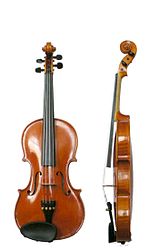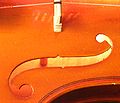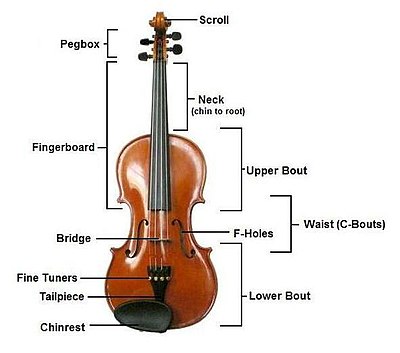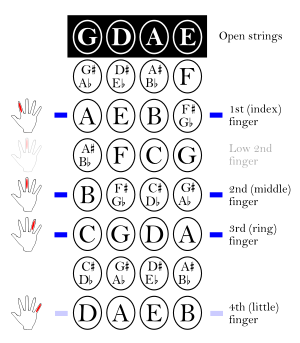violin
Violin
 A standard modern violin shown from the front and the side | |
| String instrument | |
|---|---|
| Other names | Fiddle, de: Violine or Geige, fr: Violon, it: Violino |
| Hornbostel-Sachs classification | 321.322-71 (Composite chordophone sounded by a bow) |
| Developed | Early 16th century |
| Playing range | |
| Related instruments | |
| |
| Musicians | |
| Builders | |
| More articles | |
|
This article is part of the Fiddle and Violin series. | |
The violin is a string instrument with four strings usually tuned in perfect fifths. It is the smallest and highest-pitched member of the violin family of string instruments, which also includes the viola and cello.
The violin is sometimes informally called a fiddle, regardless of the type of music played on it. The word violin comes from the Middle Latin word vitula, meaning stringed instrument;[1] this word is also believed to be the source of the Germanic "fiddle".[2] The violin, while it has ancient origins, acquired most of its modern characteristics in 16th-century Italy, with some further modifications occurring in the 18th century. Violinists and collectors particularly prize the instruments made by the Gasparo da Salò, Giovanni Paolo Maggini, Stradivari, Guarneri and Amati families from the 16th to the 18th century in Brescia and Cremona and by Jacob Stainer in Austria.
A person who makes or repairs violins is called a luthier, or simply a violin maker. The parts of a violin are usually made from different types of wood (although electric violins may not be made of wood at all, since their sound may not be dependent on specific acoustic characteristics of the instrument's construction), and it is generally strung with gut, nylon/steel composite, or steel strings.
Someone who plays the violin is called a violinist or a fiddler. The violinist produces sound by drawing a bow across one or more strings (which may be stopped by the fingers of the other hand to produce a full range of pitches), by plucking the strings (with either hand), or by a variety of other techniques. The violin is played by musicians in a wide variety of musical genres, including Baroque music, classical, jazz, folk music, pop-punk and rock and roll. The violin has come to be played in many non-western music cultures all over the world.
Contents |
History
The earliest stringed instruments were mostly plucked (e.g. the Greek lyre). Bowed instruments may have originated in the equestrian cultures of Central Asia, an example being the Kobyz (Kazakh: қобыз) or kyl-kobyz is an ancient Kazakh string instrument or Mongolian instrument Morin huur:
- Turkic and Mongolian horsemen from Inner Asia were probably the world’s earliest fiddlers. Their two-stringed upright fiddles were strung with horsehair strings, played with horsehair bows, and often feature a carved horse’s head at the end of the neck. ... The violins, violas, and cellos we play today, and whose bows are still strung with horsehair, are a legacy of the nomads.[3]
It is believed that these instruments eventually spread to China, India, the Byzantine Empire and the Middle East, where they developed into instruments such as the erhu in China, the rebab in the Middle East, the lyra in the Byzantine Empire and the esraj in India. The violin in its present form emerged in early 16th-Century Northern Italy, where the port towns of Venice and Genoa maintained extensive ties to central Asia through the trade routes of the silk road.
The modern European violin evolved from various bowed stringed instruments which were brought from the Middle East[4] and the Byzantine Empire.[5][6] Most likely the first makers of violins borrowed from three types of current instruments: the rebec, in use since the 10th century (itself derived from the Byzantine lyra[7] and the Arabic rebab), the Renaissance fiddle, and the lira da braccio[8] (derived[5] from the Byzantine lira). One of the earliest explicit descriptions of the instrument, including its tuning, was in the Epitome musical by Jambe de Fer, published in Lyon in 1556.[9] By this time, the violin had already begun to spread throughout Europe.
The oldest documented violin to have four strings, like the modern violin, is supposed to have been constructed in 1555 by Andrea Amati, but the date is very doubtful. (Other violins, documented significantly earlier, only had three strings and were called violetta.) The violin immediately became very popular, both among street musicians and the nobility, illustrated by the fact that the French king Charles IX ordered Amati to construct 24 violins for him in 1560.[10] The oldest surviving violin, dated inside, is from this set, and is known as the Charles IX, made in Cremona c. 1560. The finest Renaissance carved and decorated violin in the world is the Gasparo da Salò (1574 c.) owned by Ferdinand II, Archduke of Austria and later, from 1841, by the Norwegian virtuoso Ole Bull, who used it for forty years and thousands of concerts, for his very powerful and beautiful tone, similar to those of a Guarneri. It is now in the Vestlandske Kustindustrimuseum in Bergen (Norway). "The Messiah" or "Le Messie" (also known as the "Salabue") made by Antonio Stradivari in 1716 remains pristine. It is now located in the Ashmolean Museum of Oxford.[11]
The most famous violin makers (luthiers) between the 16th century and the 18th century include:
- The school of Brescia, beginning in the late 14 with liras, violettas, violas and active in the field of the violin in the first half of 16th century
- The Dalla Corna family, active 1510–1560 in Brescia and Venezia, Italy
- The Micheli family, active 1530–1615 in Brescia
- The Inverardi family active 1550–1580 in Brescia
- The Bertolotti Gasparo da Salò family, active 1530–1615 in Salò and Brescia
- Gio Paolo Maggini, active 1600–1630 in Brescia
- The school of Cremona, beginning in the half of 16 century vith violas and violone and in the field of violin in the second half of 16 century
- The Amati family, active 1500–1740 in Cremona, Italy
- The Guarneri family, active 1626–1744 in Cremona
- The Stradivari family, active 1644–1737 in Cremona
Significant changes occurred in the construction of the violin in the 18th century, particularly in the length and angle of the neck, as well as a heavier bass bar. The majority of old instruments have undergone these modifications, and hence are in a significantly different state than when they left the hands of their makers, doubtless with differences in sound and response.[12] But these instruments in their present condition set the standard for perfection in violin craftsmanship and sound, and violin makers all over the world try to come as close to this ideal as possible.
To this day, instruments from the so-called Golden Age of violin making, especially those made by Stradivari and Guarneri del Gesù, are the most sought-after instruments by both collectors and performers. The current record amount paid for a Stradivari violin was $3,544,000.00 at an auction on May 16, 2006. All Stradivarius violins have unique names; the record setting one is known as the Hammer, referring to its first owner, Christian Hammer. It was made in 1707.[13]
Construction and mechanics
A violin typically consists of a spruce top (the soundboard, also known as the top plate, table, or belly), maple ribs and back, two endblocks, a neck, a bridge, a soundpost, four strings, and various fittings, optionally including a chinrest, which may attach directly over, or to the left of, the tailpiece. A distinctive feature of a violin body is its hourglass-like shape and the arching of its top and back. The hourglass shape comprises two upper bouts, two lower bouts, and two concave C-bouts at the waist, providing clearance for the bow.
The voice of a violin depends on its shape, the wood it is made from, the graduation (the thickness profile) of both the top and back, and the varnish which coats its outside surface. The varnish and especially the wood continue to improve with age, making the fixed supply of old violins much sought-after.
The very great majority of glued joints in the instrument use animal hide glue for a number of reasons: it is capable of making a thinner joint than most other glues, it is reversible (brittle enough to crack with carefully applied force, and removable with warm water) when disassembly is needed, and since fresh hide glue will stick to old hide glue, more original wood can be preserved when repairing a joint. (More modern glues must be cleaned off entirely in order for the new joint to be sound, which generally involves scraping off some wood along with the old glue.) Weaker, diluted glue is usually used to fasten the top to the ribs, and the nut to the fingerboard, since common repairs involve removing these parts.
The purfling running around the edge of the spruce top provides some protection against cracks originating at the edge. It also allows the top to flex more independently of the rib structure. Painted-on faux purfling on the top is a sign of an inferior instrument. The back and ribs are typically made of maple, most often with a matching striped figure, referred to as flame, fiddleback, or tiger stripe.
The neck is usually maple with a flamed figure compatible with that of the ribs and back. It carries the fingerboard, typically made of ebony, but often some other wood stained or painted black. Ebony is the preferred material because of its hardness, beauty, and superior resistance to wear. Fingerboards are dressed to a particular transverse curve, and have a small lengthwise "scoop," or concavity, slightly more pronounced on the lower strings, especially when meant for gut or synthetic strings.
Some old violins (and some made to appear old) have a grafted scroll, evidenced by a glue joint between the pegbox and neck. Many authentic old instruments have had their necks reset to a slightly increased angle, and lengthened by about a centimeter. The neck graft allows the original scroll to be kept with a Baroque violin when bringing its neck into conformance with modern standards.

The bridge is a precisely cut piece of maple that forms the lower anchor point of the vibrating length of the strings and transmits the vibration of the strings to the body of the instrument. Its top curve holds the strings at the proper height from the fingerboard in an arc, allowing each to be sounded separately by the bow. The sound post, or soul post, fits precisely inside the instrument between the back and top, below the treble foot of the bridge, which it helps support. It also transmits vibrations between the top and the back of the instrument.
The tailpiece anchors the strings to the lower bout of the violin by means of the tailgut, which loops around an ebony button called the tailpin (sometimes confusingly called the endpin, like the cello's spike), which fits into a tapered hole in the bottom block. Very often the E string will have a fine tuning lever worked by a small screw turned by the fingers. Fine tuners may also be applied to the other strings, especially on a student instrument, and are sometimes built into the tailpiece.
At the scroll end, the strings wind around the tuning pegs in the pegbox. Strings usually have a colored silk wrapping at both ends, for identification and to provide friction against the pegs. The tapered pegs allow friction to be increased or decreased by the player applying appropriate pressure along the axis of the peg while turning it.
Strings
Strings were first made of sheep gut (commonly known as catgut), stretched, dried and twisted. Modern strings may be gut, solid steel, stranded steel, or various synthetic materials, wound with various metals, and sometimes plated with silver. Most E strings are unwound, either plain or gold-plated steel.
Strings have a limited lifetime; apart from obvious things, such as the winding of a string coming undone from wear, a player will generally change a string when it no longer plays true, losing the desired tone. The longevity of a string depends on how much and how intensely one plays.
Pitch range
The compass of the violin is from G3 (G below middle C) to C8 (the highest note of the modern piano.) The top notes, however, are often produced by natural or artificial harmonics. Thus the E two octaves above the open E-string may be considered a practical limit for orchestral violin parts[14].
Acoustics
The arched shape, the thickness of the wood, and its physical qualities govern the sound of a violin. Patterns of the node made by sand or glitter sprinkled on the plates with the plate vibrated at certain frequencies, called Chladni patterns, are occasionally used by luthiers to verify their work before assembling the instrument.[15]
Sizes
Children typically use smaller string instruments than adults. Violins are made in so-called fractional sizes for young students: Apart from full-size (4/4) violins, 3/4, 1/2, 1/4, 1/8, 1/10, 1/16, and even 1/32-sized instruments exist. Extremely small sizes were developed, along with the Suzuki program, for violin students as young as 3. Finely-made fractional sized violins, especially smaller than 1/2 size, are extremely rare or non-existent. Such small instruments are typically intended for beginners needing a rugged violin, and whose rudimentary technique does not justify the expense of a more carefully made one.
These fractional sizes have nothing to do with the actual dimensions of an instrument; in other words, a 3/4-sized instrument is not three-quarters the length of a full size instrument. The body length (not including the neck) of a full-size, or 4/4, violin is about 14 inches (35 cm), smaller in some 17th century models. A 3/4 violin is about 13 inches (33 cm), and a 1/2 size is approximately 12 inches (30 cm). With the violin's closest family member, the viola, size is specified as body length in inches or centimeters rather than fractional sizes. A full-size viola averages 16 inches (40 cm).
Occasionally, an adult with a small frame may use a so-called 7/8 size violin instead of a full-size instrument. Sometimes called a lady's violin, these instruments are slightly shorter than a full size violin, but tend to be high-quality instruments capable of producing a sound that is comparable to that of fine full size violins.
Tuning
Violins are tuned by turning the pegs in the pegbox under the scroll, or by adjusting the fine tuner screws at the tailpiece. All violins have pegs; fine tuners (also called fine adjusters) are optional. Most fine tuners consist of a metal screw that moves a lever to which the string is attached. They permit very small pitch adjustments with much more ease than the pegs.
Fine tuners are usually used with solid metal or composite strings that may be difficult to tune with pegs alone; they are not used with gut strings, which are more elastic and do not respond adequately to the very small movements of fine tuners. Some violinists have fine tuners on all 4 strings; most classical players have only a single fine tuner on the E string.
To tune a violin, the A string is first tuned to a standard pitch (usually 440 Hz), using either a tuning device or another instrument. (When accompanying a fixed-pitch instrument such as a piano or accordion, the violin tunes to it.) The other strings are then tuned against each other in intervals of perfect fifths by bowing them in pairs. A minutely higher tuning is sometimes employed for solo playing to give the instrument a brighter sound; conversely, Baroque music is sometimes played using lower tunings to make the violin's sound more gentle. After tuning, the instrument's bridge may be examined to ensure that it is standing straight and centered between the inner nicks of the f-holes; a crooked bridge may significantly affect the sound of an otherwise well-made violin.
The tuning G-D-A-E is used for most violin music. Other tunings are occasionally employed; the G string, for example, can be tuned up to A. The use of nonstandard tunings in classical music is known as scordatura; in some folk styles, it is called cross-tuning. One famous example of scordatura in classical music is Saint-Saëns' Danse Macabre, where the solo violin's E string is tuned down to E flat to impart an eerie dissonance to the composition. Another example would be in the third movement of Contrasts, by Béla Bartók, where the E string is tuned down to E flat and the G tuned to a G sharp, or the set of pieces called the Mystery Sonatas by Biber.
In Indian classical music and Indian light music, the violin is likely to be tuned to D♯-A♯-D♯-A♯ in the South Indian style. As there is no concept of absolute pitch in Indian classical music, any convenient tuning maintaining these relative pitch intervals between the strings can be used. Another prevalent tuning with these intervals is F-B♭-F-B♭, which corresponds to Sa-Pa-Sa-Pa in the Indian carnatic classical music style. In the North Indian Hindustani style, the tuning is usually Pa-Sa-Pa-Sa instead of Sa-Pa-Sa-Pa. This could correspond to B♭-F-B♭-F, for instance.
While most violins have four strings, there are violins with as many as seven strings. The extra strings on such violins typically are lower in pitch than the G-string; these strings are usually tuned to C, F, and B flat. If the instrument's playing length, or string length from nut to bridge, is equal to that of an ordinary full-scale violin; i.e., a bit less than 13 inches (330 mm), then it may be properly termed a violin. Some such instruments are somewhat longer and should be regarded as violas. Violins with five strings or more are often used in jazz or folk music.
Bows
A violin is usually played using a bow consisting of a stick with a ribbon of horsehair strung between the tip and frog (or nut, or heel) at opposite ends. A typical violin bow may be 75 cm (29 inches) overall, and weigh about 60 g (2.1 oz). Viola bows may be about 5 mm (0.20 in) shorter and 10 g (0.35 oz) heavier.
At the frog end, a screw adjuster tightens or loosens the hair. Just forward of the frog, a leather thumb cushion and winding protect the stick and provide a strong grip for the player's hand. The winding may be wire (often silver or plated silver), silk, or whalebone (now imitated by alternating strips of tan and black plastic.) Some student bows (particularly the ones made of solid fiberglass) substitute a plastic sleeve for grip and winding.
The hair of the bow traditionally comes from the tail of a grey male horse (which has predominantly white hair), although some cheaper bows use synthetic fiber. Occasional rubbing with rosin makes the hair grip the strings intermittently, causing them to vibrate. The stick is traditionally made of brazilwood, although a stick made from this type of wood which is of a more select quality (and higher price) is referred to as pernambuco (both types are taken from the same tree species). Some student bows are made of fiberglass or various cheap woods. Recent innovations have allowed carbon fiber to be used as a material for the stick at all levels of craftsmanship.
Playing
The standard way of holding the violin is with the left side of the jaw resting on the chinrest of the violin, and supported by the left shoulder, often assisted by a shoulder rest. This practice varies in some cultures; for instance, Indian (Carnatic and Hindustani) violinists play seated on the floor and rest the scroll of the instrument on the side of their foot. The strings may be sounded by drawing the hair of the bow across them (arco) or by plucking them (pizzicato). The left hand regulates the sounding length of the string by stopping it against the fingerboard with the fingertips, producing different pitches.
Left hand and pitch production
As the violin has no frets to stop the strings, the player must know exactly where to place the fingers on the strings to play with good intonation. Through practice and ear training, the violinist's left hand finds the notes intuitively by muscle memory. Beginners sometimes rely on tapes placed on the fingerboard for proper left hand finger placement, but usually abandon the tapes quickly as they advance. Another commonly-used marking technique uses dots of white-out on the fingerboard, which wear off in a few weeks of regular practice. This practice, unfortunately, is used sometimes in lieu of adequate ear-training, guiding the placement of fingers by eye and not by ear. Especially in the early stages of learning to play, the so-called ringing tones are useful. There are nine such notes in first position, where a stopped note sounds a unison or octave with another (open) string, causing it to resonate sympathetically. Thus, "when unaccompanied, [a violinist] does not play consistently in either the tempered or the










